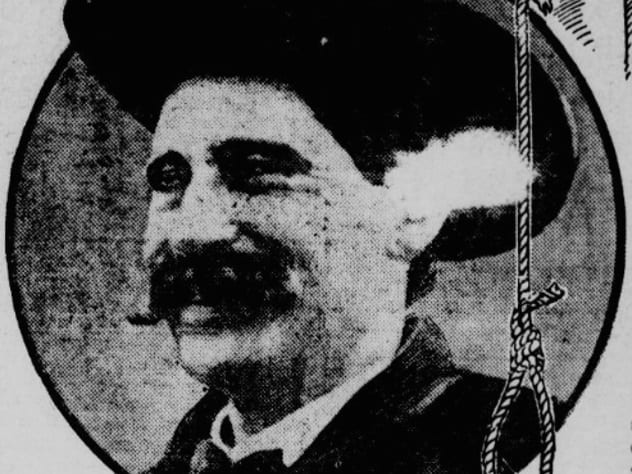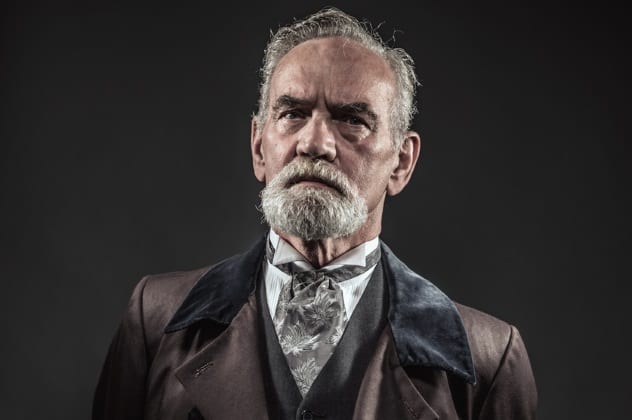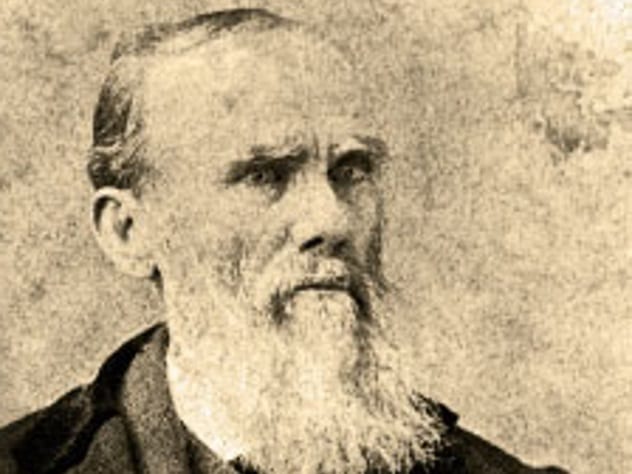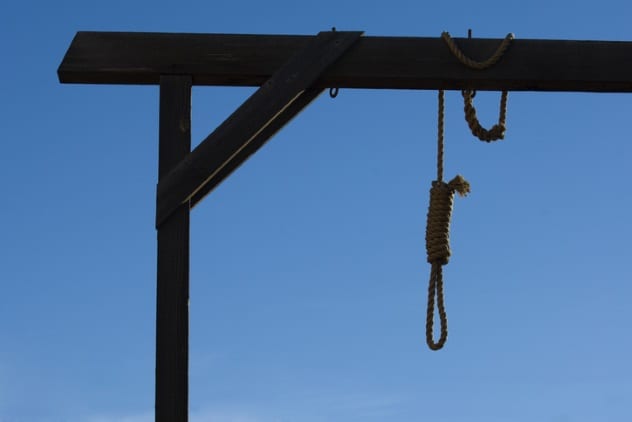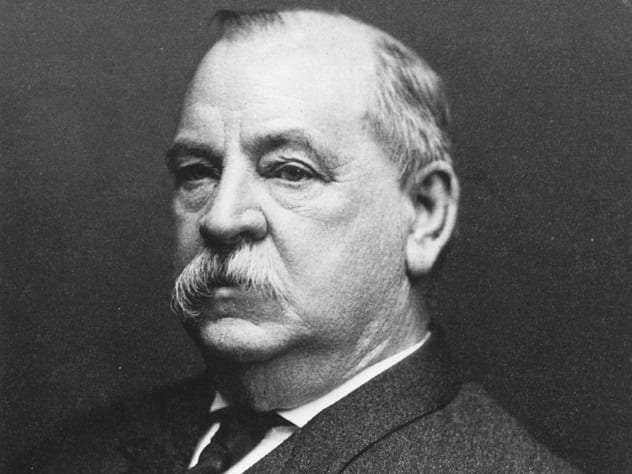In many cases, a sheriff or deputy would act as the hangman, and for a great number of these executions, the condemned was forced to suffer a long and agonizing death. Hanging was not quick like Anatole Deibler’s well-oiled guillotine, and men could be left to hang for hours before being cut down simply because their necks did not snap on the drop.
10 The Unnamed New York Choker
In 1885, one reporter had the opportunity to get to know a prolific hangman in New York City who often worked with the noose at the Tombs. After meeting with the hangman at a bar, the reporter was invited to his home. Upon entering the brick residence, everything seemed normal and average, until he was invited into the hangman’s chamber of horror: On the walls were tacked numerous photographs of murderers who had paid the penalties of their crimes upon the scaffold. Many of these were taken from life, while others represented murderers in the coffin. A neatly framed photograph of a full-sized scaffold was suspended above a closet door and on the opposite wall hung the motto, “GOD IS LOVE.” As if this weren’t creepy enough, there was a special chest in the room, filled with artifacts from the hangman’s occupation: It was at night when the visit was made to this dingy little room, and the rays from a dim lamp fell upon the blood stained and greasy nooses and black caps which were piled together in a huge old chest which the hangman opened. [ . . . ] Twenty-four of these horrible and deathly looking black caps, which served to conceal the distorted features of as many murderers who died on the gallows, and twenty-four nooses which strangled these unfortunates, were exhibited.[1]
9 Angus Macauley
The hanging of Mary Rogers in 1905 was a botched job performed by an unseasoned hangman, Angus Macauley. First, the rope was too long, and when Mary plunged downward, her feet touched the floor beneath her. Then, in an act of cruelty and panic, Angus and his men ran to the top of the scaffold and pulled upward on the rope so that Mary’s feet would no longer touch. Instead of hanging her a second time, they allowed her to slowly choke to death. Angus was the deputy sheriff at that time and openly felt that it was his duty to carry out the law. However, he had nothing but complaints when people would point to him in his little Vermont town and say, “There goes the man who hanged Mary Rogers.”[2]
8 Amos Lunt
Amos Lunt was the infamous San Quentin hangman. He was described as having a “full career” as a state executioner who served for seven years. During his time, he hanged 19 murderers. He was said to behave rather calmly after each execution: In one morning he hanged three men and then sauntered from the execution room smoking a cigarette. However, his close friends knew this was hardly the case. Each hanging weighed deep on him until finally the man snapped in 1901: Therefore it caused little surprise when on falling into a fortune about two years ago, he promptly resigned his position. Some months later he returned to the position and resumed his duties as hangman, although the prospect of arranging the rope on another man seemed to appall him. He constantly talked about it and brooded over it and suddenly one morning the iron nerve snapped and he became a hopeless madman.[3]
7 Jack Holmes
Hangman Holmes, as he was sometimes called, should have been called Bungling Jack, instead. This Canadian hangman seemed to have a lot of problems when it came to his job. In 1914, it was reported that a 22-year-old man from Missouri was accused of having murdered a farmer (or a lawyer or policeman, according to different accounts) in Calgary. He was given the death sentence, but something happened to him between the sentencing and the noose. William J. Collins was in a near-comatose state. Despite the condemned being very ill, the Calgary Mounties went ahead with the private execution and had a doctor shoot Collins up with some drugs to get the man to walk. When Collins reached the scaffold, Hangman Holmes was visibly nervous and fumbled with the noose as he adjusted it around Collins’s neck. With Collins finally in place: . . . the trap was sprung, the rope slipped up, caught the boy around the chin, and when he was cut down fifteen minutes later he was groaning. Faint groans still came from the body as it was placed beside the rough coffin, but as life was ebbing fast, Collins was permitted to pass out of the world without being again hanged.[4] Unfortunately, this was not the first time Hangman Holmes bungled an execution. In 1909, during the execution of Garry Barrett, the hangman did not tie the noose properly, and it took Barrett a slow 15 minutes of strangulation to die.
6 Mr. Van Hise
To say that Hangman Van Hise loved his job would be an understatement. He appeared to get enjoyment out of making condemned men suffer and making those around him extremely uneasy. During the execution of Edward Clifford in New Jersey in 1900, the hangman gave everyone the willies: At the south end of this place was the scaffold and standing beside it the hangman, “Mr. Van Hise,” as he insists on being called, lovingly fingered the rope and glanced at the jurors with a look as if he would like to “work off” the whole lot at $250 per head. He was in the midst of his enjoyment when Warden Sullivan appeared at the door of the corridor and beckoned to him. The hangman walked out quickly, the talon like fingers of his right hand ominously clutching his throat.[5] If that isn’t a damning description of a man, what followed was even more horrible. Van Hise had once again bungled the placement of the noose knot. During a previous execution gone wrong, Van Hise was shown that his placement of the knot was wrong and caused men to slowly strangle to death instead of getting a clean neck snap. Van Hise obviously wanted his victims to suffer. He intentionally misplaced the noose knot on Clifford’s neck, and Clifford was slowly strangled. After several minutes had passed, Clifford’s rope was lowered so that his feet were only a few inches from the ground. Doctors rushed to check him for signs of life and found that Clifford still had some life left in him, so he was left to strangle some more. After death, doctors examined the body and discovered that the neck of the condemned had not been snapped, and it was all because Van Hise refused to “learn” how to place the noose knot under the victim’s left ear.
5 George Maledon
He was called the Prince of Hangmen, but much of his story is unknown. George Maledon probably began hanging men in the state of Arkansas in 1873. Some accounts claim that he hanged 50 men during his career, while other reports say he hanged 88 men before he retired in 1891. Unlike other hangmen, Maledon appeared to take his job seriously. According to a newspaper article published in 1896: A hanging by Maledon was worth going miles to see. It was a thing of scientific beauty. From the moment the subject began to prepare for the march to the scaffold, the little Dutch hangman was at his heels. He had been up before daylight, greasing his ropes, oiling the hinges of the gallows trap, and adjusting and readjusting his noose.[6] Maledon was always eager for the job to get done. If the condemned would falter in any way, Maledon would say, “Oh, come on, now. It’s nothing at all. You won’t feel it, and I’ll have it all over in a jiffy.” Experience taught Maledon how to kill with a noose. He had bungled his first few executions, with one man slowly choking to death and another man nearly decapitated by the fall. To ensure a quick and bloodless death, Maledon began practicing his technique on bags of sand, each bag weighing anywhere from 41 to 102 kilograms (90–225 lb). After his study of weights and heights, hanging the condemned became almost second nature to him.
4 George Lawson
After George Maledon retired, George Lawson took his place at the gallows and was Cherokee Bill’s hangman. While Lawson never gained the cult celebrity status of Maledon, he was certainly a busy man, with newspaper articles claiming that he hanged over 100 men. His cool demeanor and his quick pull of the iron pin that released the trapdoor made many people uneasy around him. An article published in 1905 mentioned how hard Lawson’s first hanging was on the psyche: He said that the first time he did it he dreamed about the dying man for weeks afterward, but he soon got over that and cared nothing for assisting in putting away the hardened characters sentenced at Fort Smith. He really thought he was doing them a favor. He had hanged five men at one time and never flinched as they shot through the trap and struggled a few minutes until relieved by unconsciousness.[7]
3 Arthur B. English
Canadian hangman Arthur B. English preferred to be called “Arthur Ellis” after his idol, John Ellis, the British hangman who hanged the condemned for 23 years. Most of the stories published about Arthur Ellis were about how much money he made. According to one report, he made anywhere from $100 to $250 plus expenses for each execution. In 1921, it was reported that he had earned $12,500 the previous year. However, in 1922, after being accused of assaulting his wife, Arthur Ellis said he could only afford to give her $75 a month during their separation. He claimed that it was impossible to earn more money, due to the nature of his business. After leaving court, he went to Vancouver to execute three more men.[8] Over his entire career as a hangman, it is believed that he may have executed more than 400 people.
2 Sheriff Tom Harrison
There are numerous accounts of sheriffs conducting hangings in the local jails. While the hangings were common business, sometimes unusual circumstances surrounded the hanging, such as the “special” rope . . . In 1914, a Texas sheriff, Tom Harrison, wrote a letter to another local sheriff, requesting a certain rope: Leon Martinez, sentenced to hang for the murder of a white girl (Miss Brown) at Saragosa about 2-1/2 years ago, will be hanged here April 21st. I understand you have a rope and a cap that has officiated several times in these matters. I would like to use them . . .[9] The rope and cap were first used to execute a white man who murdered a German farmer. The second execution was of a Mexican who was accused of murdering a white girl. Next, it was used to hang a black man who was accused of murdering a black woman. Because the rope had done its job in getting rid of accused murderers, both items together appeared to become legendary in the region. Naturally, Sheriff Futch expressed the deadly rope and cap to Harrison, and the hanging was completed.
1 Grover Cleveland
Not only was Grover Cleveland the 22nd and 24th president of the United States, but he was also a hangman. Before running for president in 1884, he was a sheriff in Erie County, New York. In New York, when it came time to hang a criminal, sheriffs were allowed to hire a hangman to do the dirty job. Cleveland chose to perform the executions himself. The first man he hanged was Patrick Morrissey, on September 6, 1872: At 12:10, the signal was given, the Sheriff pressed the lever, and the soulless body of the matricide hung dangling in the air. The name of this Sheriff who preferred to do the hanging with his hands, rather than pay for it, was Grover Cleveland.[10] The second man hanged by Cleveland was John Gaffney on February 14, 1873. Even though Sheriff Cleveland had only stood as executioner for two people, he was nicknamed “the hangman of Buffalo.” Elizabeth is a full-time freelance writer and enjoys researching early American history. When she is not busy digging through newspaper archives, she is usually traveling to historical sites throughout the US.

